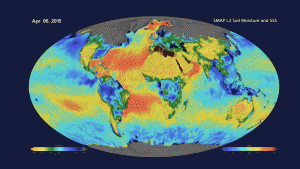
This animation shows a time lapse of sea surface salinity and soil moisture from NASA’s Soil Moisture Active Passive (SMAP) satellite from April 2015 through February 2019. (Credit: NASA/JPL-Caltech/GSFC)
Our oceans and the complex “conveyer belt” system of currents that connects them play an important role in regulating global climate. The oceans store heat from the Sun, and ocean currents transport that heat from the tropics to the poles. They release the heat and moisture into the air, which moderates climate nearby. But what happens if part of that conveyer belt jams?
It’s not a theoretical question. Scientists have observed that a major ocean current called the Indonesia Throughflow, which provides the only tropical connection between the Pacific and Indian oceans, slows dramatically near the surface during the Northwest Asia monsoon season”usually December through March. And a team of scientists, led by Tong Lee of NASA’s Jet Propulsion Laboratory in Pasadena, California, has figured out why.
We have found that this current, which is a very important element of the global ocean current system, is significantly affected by local precipitation, Lee said. It is fairly common knowledge that winds drive ocean currents. In this case, however, the precipitation is actually a dominant factor during the monsoon season.
It’s a discovery that will improve our understanding of complex Earth processes. During this season, about 10 feet (3 meters) of rain fall over the maritime continent, a region of Southeast Asia between the Indian and Pacific oceans through which the Indonesia Throughflow current travels. This influx of local rain reduces the pressure force that drives the current through the region. Although the slowing of this current is primarily seasonal, it still affects the amount of heat transported from the Pacific Ocean to the Indian Ocean, which can change regional climate in Southeast Asia.
Titled Maritime Continent water cycle regulates low-latitude chokepoint of global ocean circulation, the study was recently published in Nature.

